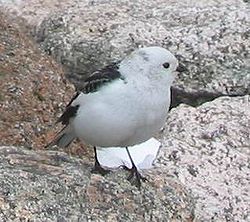Species
The genus contains two species, which may be conspecific. [3] [4]
| Image | Scientific name | Common name | Distribution |
|---|
 | Plectrophenax nivalis | Snow bunting | Arctic region, including the Cairngorms in central Scotland and the Saint Elias Mountains on the southern Alaska-Yukon border, as well as the Cape Breton Highlands |
 | Plectrophenax hyperboreus | McKay's bunting | Bering Sea, St. Matthew and Hall islands, and winters on the western coast of the U.S. state of Alaska |
|
They are high Arctic breeding seed-eating birds with stubby, conical bills, and much white in the plumage, especially in adult males. They nest in rock crevices. As would be expected, both species are highly migratory, wintering in more temperate areas.
The plumages are similar, but McKay's has more white and less black in the plumage, especially in the wings and tail. Adult breeding males of both species are mainly white with contrasting black on at least the wings, but are duller in winter. Females have white and brown plumage. The calls of both species are identical and include a low warbled hudidi feet feet feew hudidi feet feet feew hudidi.


